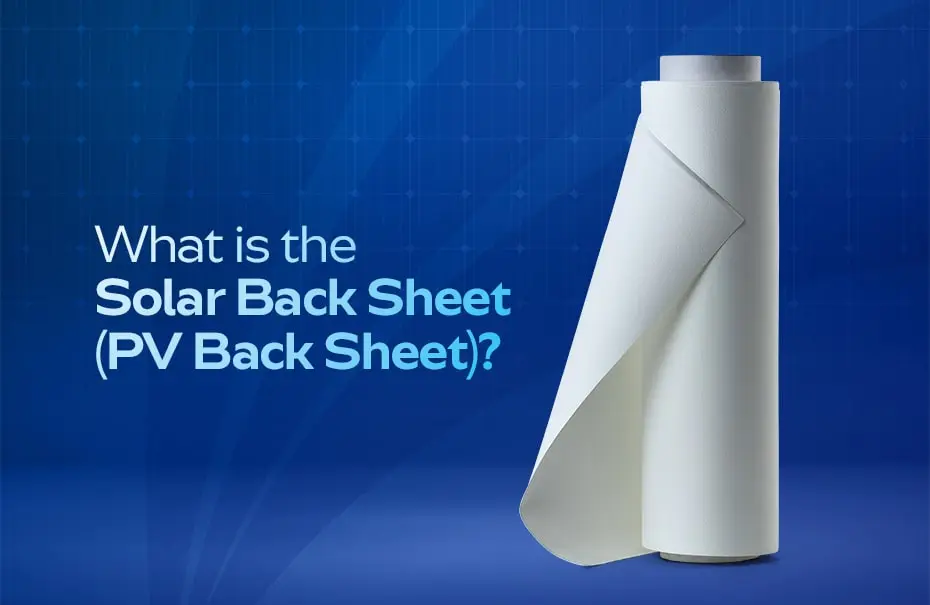A Comprehensive Guide on Solar Back Sheet for Solar Panels

The solar backsheet is a crucial component of a solar panel as it safeguards the photovoltaic cells against environmental and electrical harm. It is the layer of material found at the back of the panel that comes in contact with the mounting surface. The solar backsheet is primarily responsible for providing insulation and protecting the PV cells from moisture, UV light, and other external elements that could harm their performance. It also ensures the structural integrity of the solar panel by acting as a barrier against potential impacts or stress.
This article discusses how the solar backsheet works, what its purpose is, and things to consider when deploying it in solar panels.
What is a Solar Backsheet?
The outer layer of a solar panel that serves as the primary defense for solar module components, particularly the solar cells, is known as a solar backsheet.
It works by safeguarding solar panels against different and severe environmental conditions, UV radiation, moisture, dust, etc., throughout their lifespan. Made from polymer materials such as EVA, polyester, or fluoropolymer, solar backsheets are designed to withstand the effects of exposure to sunlight and temperature changes over time. They may also include additional materials like aluminum or a layer of glass for added protection.
Role of Solar Backsheet
Below are the vital roles of Solar Backsheets that you must know before choosing one for your solar panel:
Protects the Cells from Overheating
Backsheets play an important role in safeguarding photovoltaic cells from adverse and extreme temperatures. By acting as a protective barrier, they prevent the cells from getting exposed to high-energy photons that could cause thermal stress and potentially damage the cells or lower their efficiency.
Eliminates the Possibility of Mechanical Stress on the PV Cells
Solar backsheets provide a rigid and robust support structure for the PV cells, which helps to minimize the mechanical stress that they may otherwise experience. The rigidity helps the solar panel to stay upright and prevents vibrations from affecting the overall structure.
Shields from Water and Moisture
The layer of the backsheet acts as a protective cover against water and moisture. In photovoltaic modules, moisture accumulation can lead to the corrosion of metal parts. Backsheets act as a preventive mechanism to stop moisture and minimize the possibility of insulation degradation, short-circuiting, and corrosion of electrical connections or components.
Defends the Electric Components of the Solar Module by Insulating
Backsheets safeguard the electrical components of a solar module by providing insulation and ensuring their longevity. Owing to their dielectric strength, they allow for the safe generation of electricity by insulating the electrical components within the module.
Key Criteria for Choosing Solar Backsheet Material
Weatherability
The term ‘weatherability’ pertains to the capacity of the backsheet to endure prolonged exposure to severe weather conditions and temperature changes without experiencing component deterioration or performance degradation. The solar panel’s overall efficiency and lifespan can be affected by a backsheet that has inadequate weatherability, as it may crack or get delaminated.
Electric Insulation
Electric insulation refers to the resistance to electric flow. The backsheet serves as a protective barrier that insulates electric components of the solar panel. Backsheet has dielectric strength that prevents its electrical breakdown and it can withstand high voltage. The appropriate backsheet is essential for insulating solar cells, as it prevents the possibility of short circuits and other electrical failures.
Mechanical Power
The term ‘mechanical strength’ is the capacity of the backsheet to withstand mechanical pressures like collision, strike from any object, and abrasion. Backsheets lacking sufficient mechanical strength cannot prevent any potential damage to the cells. Therefore, it is crucial that the backsheet has adequate tensile strength to ensure the physical robustness and durability of the solar cells.
Adhesion
The term ‘adhesion’ refers to the capacity of the solar panel’s backsheet to uphold its connection/bond with the other parts of the solar panel. Inadequate adhesion results in delamination and segregation of the various layers, resulting in a decline in the solar panel’s performance/output.
Preventing Solar Backsheet Degradation During Deployment
Some manufacturers compromise on quality and adopt inexpensive materials for the backsheet layers to reduce costs. If a low-quality solar backsheet is used, it can lead to several issues, such as system degradation, increased maintenance costs, and additional expenses for replacements, claims, and laboratory tests. Therefore, it is critical to follow the best practices and choose the backsheet brand carefully.
The below tips will help you make a prudent decision:
- Carefully inspect the quality and thickness of the backsheet prior to purchase to prevent additional expenses for repairs or damages. Thinner backsheet layers are more susceptible to moisture and can ultimately damage the solar module components.
- It is also crucial to verify the company’s certification and ensure that the backsheets adhere to the most recent guidelines. Choose manufacturers that follow regulatory practices and adhere to current IEC standards and regulations to ensure the quality and integrity of the backsheet.
- To avoid using inefficient backsheets, it is essential to prioritize the quality of the product before making any decisions. When selecting a solar panel backsheet, it is important to consider using PET with high stability, PVDF, or PVF to strengthen a weak core.
- When deploying solar backsheets, it is important to take into account potential issues such as delamination, bubbling, cracking, and yellowing, which can all indicate early signs of backsheet failure.
Final Words
When selecting backsheets, the cost is a crucial consideration. The solar backsheet is crucial in safeguarding the solar panel. Any substandard or low-quality backsheet can lead to the degradation of the PV system resulting in unwanted maintenance and additional replacement expenses. A high-quality solar backsheet provides protection against various environmental factors, humidity, vapor penetration, wind, dust, etc.
If you are looking for high-quality solar backsheets that come with ultimate Dielectric strength, excellent moisture protection, superior electric insulation, and robust thermal protection, then look no further than solar backsheets by Vishakha Renewables.
